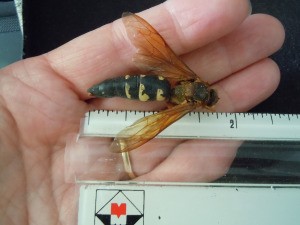I have a flying bug in my front yard that resembles a bee, but is much bigger. It has dug 2 big holes at the edge of my grass. One hole has a mound of sand next to it. The other has a channel of sand. I don't know if they are dangerous. This is right next to my walk way. Please help.
Add your voice! Click below to answer. ThriftyFun is powered by your wisdom!
It could be a hornet or yellow jacket. They can hurt you with their stings. You need to find and destroy the nest. Do this before twilight, when they return to the next.
Here are a few bees like flying insects:
One, solitary bees - normally bees, wasps and hornets live in a social group. However, there are a few species of bees that live singly.
Two, it could be a digger bee or mining bee. They too are solitary insects and they dig small burrows in the soil.
Three, ground asps are solitary wasps that dig into the soil for nesting. There are several different kinds of ground nesting wasps. They include, scolid, spider, and cicada killer wasps.
There are several different kinds of "bugs" that resemble bees that make burrows in the ground and some of them are very beneficial as they eat other bad bugs, grubs, pollinate plants, and eat other arthropods in lawns, so please read about them before getting rid of them.
www.thoughtco.com/
www.hunker.com/
It sounds like a Burrowing Bee. They are a type of bee that lives a fairly seclusive life and are pretty harmless to humans if left alone, but are good for the garden and flowers. Here is a very informative article: entomology.cals.cornell.edu/
i have these too! I think they're some sort of carpenter bee
I don't know, but I'm in upstate NY (near Ottawa) and I have a feeling these are what I just saw in my backyard. Hot summer, so the ground is dry. These bugs have fiery orange bodies with black wings and fly like a bee would.
This sounds like a Cicada Killer Wasp. The female digs a hole about 1" in diameter, and 12" deep,with several small "rooms" in the tunnel, leaving up to a pound of dirt outside of it. She then stings a Cicada, paralyzing it, and brings it to one of the rooms, and lays an egg next to it, till her tunnel is full. The larvae soon hatch, feed on the cicadas, make a cocoon, and stay there till they emerge the next summer. We have had one or two each year since 2014.

Add your voice! Click below to answer. ThriftyFun is powered by your wisdom!